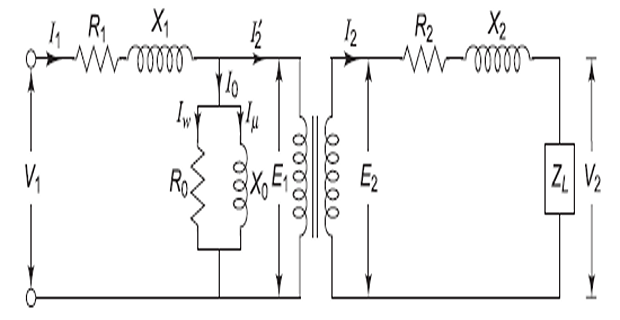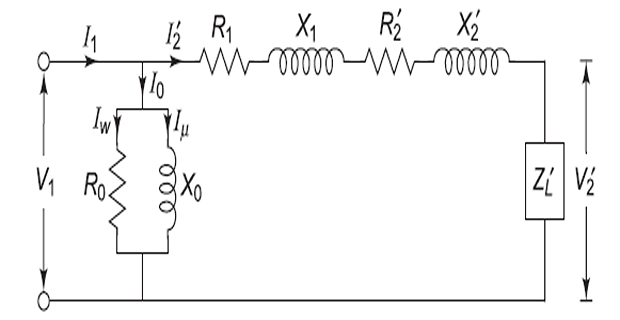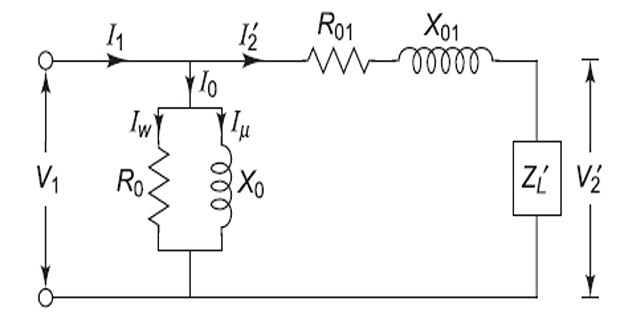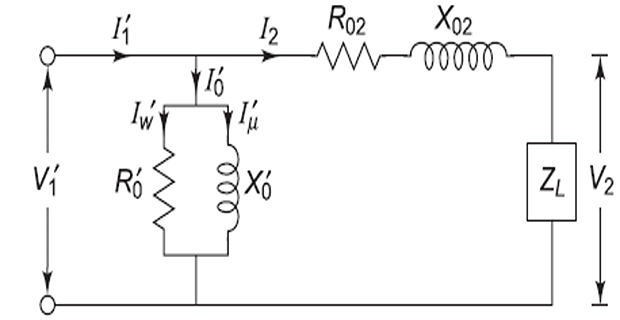Unlocking Transformer Secrets: OC & SC Tests for Performance Analysis
Demonstrative Video
VIDEO
Equivalent Circuit
\[\begin{aligned}
I_1^2R_2'& =I_2^2R_2 ~ \Leftarrow~\text{same power loss} \\
\Rightarrow~R_2'&
=\left(\frac{I_2}{I_1}\right)^2R_2=\frac{R_2}{K^2} \\
&\\
&\boxed{R_2' = \frac{R_2}{K^2}} ~\qquad
~\boxed{X_2' = \frac{X_2}{K^2}}
\end{aligned}\]
Equivalent parameters referred to
primary:
\[\begin{aligned}
R_{01} & =R_1+R_2'=R_1+\dfrac{R_2}{K^2} \\
X_{01} & =X_1+X_2'=X_1+\dfrac{X_2}{K^2} \\
Z_{01} & =\sqrt{R_{01}^2+X_{01}^2}
\end{aligned}\]
Equivalent parameters
referred to secondary:
\[\begin{aligned}
R_{02} & =R_2+R_1'=R_2+K^2 \cdot R_1 \\
X_{02} & =X_2+X_1'=X_2+ K^2 \cdot X_1 \\
Z_{02} & =\sqrt{R_{02}^2+X_{02}^2} = K^2 \cdot Z_{01}
\end{aligned}\]
Remember
Shifting primary R/X to the secondary, multiply it by \(K^2\)
Shifting secondary R/X to the primary, divide it \(K^2\)
Voltage Regulation
Transformer loaded, \(V_2~\downarrow\) due to a drop across \(R_2\) and \(X_2\) .
\[\begin{aligned}
\text{Regulation} &
=\frac{\left(\begin{matrix}\text{Secondary terminal}\\ \text{voltage on
no load}\end{matrix}\right)-\left(\begin{matrix}\text{Secondary
terminal}\\ \text{voltage on full
load}\end{matrix}\right)}{\text{Secondary terminal voltage on no
load}}\\
& = \dfrac{E_2-V_2}{E_2} \\
\text{%Regulation} & = \dfrac{E_2-V_2}{E_2} \times 100
\end{aligned}\]
. from no load
to full load conditions, expressed as a fraction of the no-load
secondary voltage is called Change in
\[\begin{aligned}
\text{Total voltage drop} & =E_2-V_2\\
&=O C-O A\\
&=O M-O A\\
&=A M=A N+N M\\
\end{aligned}\]
\[\begin{aligned}
\text { Approximate voltage drop } & \approx A N
\quad(\because N M \text { is very small) } \\
& =A D+D N \\
& =A D+B L \\
& =I_2 R_{02} \cos \phi+I_2 X_{02} \sin \phi \\
\% \text { regulation } & =\frac{I_2 R_{02} \cos \phi+I_2
X_{02} \sin \phi}{E_2} \times 100
\end{aligned}\]
For leading pf, Approximate voltage drop
\[\begin{aligned}
&\boxed{\% \text { regulation } =\frac{I_2 R_{02} \cos \phi \pm
I_2 X_{02} \sin \phi}{E_2} \times 100}\\
+ &~~ \text{lagging pf} \qquad
- ~~ \text{leading pf}
\end{aligned}\]
\[\begin{aligned}
\% {\color{red}{\textbf{regulation}}} &
=\frac{I_1 R_{01} \cos \phi \pm I_1 X_{01} \sin \phi}{V_1} \times 100
\quad \Leftarrow~\text{primary side}\\
& \\
\% \text { regulation } & =\frac{100 I_2 R_{02}}{E_2} \cos \phi
\pm \frac{100 I_2 X_{02}}{E_2} \sin \phi \\
& =\boxed{v_r \cos \phi \pm v_x \sin \phi }\\
&\boxed{v_r =\frac{ I_2 R_{02}}{E_2}\times 100}=
{\color{magenta}{\textbf{percentage resistive drop }}}\\
& \boxed{v_x =\frac{I_2 X_{02}}{E_2}\times 100}=
{\color{blue}{\textbf{percentage reactive drop }}}
\end{aligned}\]
Efficiency
\[\begin{aligned}
\eta & =\dfrac{\mbox{output power}}{\mbox{input power}}\\
&=\dfrac{\mbox{output power}}{\mbox{output power+losses}}\\
& =\dfrac{\mbox{output power}}{\mbox{output power+iron
losses+copper losses}}\\
&
\boxed{=\dfrac{V_{2}I_{2}\cos\Phi_{2}}{V_{2}I_{2}\cos\Phi_{2}+P_{i}+P_{c}}}
\end{aligned}\]
where
If \(x\) is the fraction of the
full-load, then efficiency is given as
\[\begin{aligned}
\eta_{x} &
=\boxed{\dfrac{x\times\mbox{Output}}{x\times\mbox{Output}+P_{i}+x^{2}P_{c}}}\\
&=\boxed{\dfrac{xV_{2}I_{2}\cos\Phi_{2}}{xV_{2}I_{2}\cos\Phi_{2}+P_{i}+x^{2}I_{2}^{2}R_{T}}}
\end{aligned}\]
Condition for the maximum
efficiency
\[\eta =
\dfrac{V_2I_2\cos\Phi_2}{V_2I_2\cos\Phi_2+P_i+I_2^2R_T} =
\dfrac{V_2\cos\Phi_2}{V_2\cos\Phi_2+P_i/I_2+I_2R_T}\]
\(V_2\) is constant
for a given \(\cos\Phi_2\) ,
\(\eta\) depends upon \(I_2\)
\[\begin{aligned}
\dfrac{d}{dI_{2}} &
=\left(V_{2}\cos\Phi_{2}+\dfrac{P_{i}}{I_{2}}+I_{2}R_{T}\right)=0\\
& \Rightarrow0-\dfrac{P_{i}}{I_{2}^{2}}+R_{T}=0\\
& \Rightarrow P_{i}=I_{2}^{2}R_{T}\\
& \boxed{\Rightarrow\mbox{Iron loss}=\mbox{copper loss}}
\end{aligned}\]
efficiency will be maximum when
\[I_2 = \sqrt{\dfrac{P_i}{R_T}}\]
For maximum
efficiency . Then is the fraction of full load KVA at
which If
Value of output current
for maximum efficiency
OC & SC Tests
Open-Circuit Test
(OC)
Purpose
iron loss or core loss (\(W_i\) )
magnetising resistance (\(R_0\) )
magnetising reactance (\(X_0\) )
Test
Connections
HV open and supply and meters are connected to LV side
ammeter indicates no-load current (3-5% of F.L current)
Cu losses negligible and wattmeter indicates iron loss
\[\begin{aligned}
& \text { Wattmeter reading }=W_i \\
& \text { Voltmeter reading }=V_1 \\
& \text { Ammeter reading }=I_0 \\
& W_i=V_1 I_0 \cos \phi_0 \\
& \boxed{\cos \phi_0=\frac{W_i}{V_1 I_0}} \\
& \boxed{I_w=I_0 \cos \phi_0} \qquad \boxed{I_\mu=I_0 \sin
\phi_0} \\
& \boxed{R_0=\frac{V_1}{I_w}}\\
& \boxed{X_0=\frac{V_1}{I_\mu}} \\
&
\end{aligned}\]
Calculation:
Short-Cicuit Test
(SC)
Purpose
full-load copper loss
equivalent resistance (\(R_{01}\) or \(R_{02}\) )
equivalent reactance (\(X_{01}\)
or \(X_{02}\) )
Test
Connections
LV side short-circuited while low-voltage is applied to other
winding
Applied voltage slowly increased until F.L. current flows in the
winding
Normally, the applied voltage is 5 to 10% of the rated
voltage
Flux produced in core small & iron losses are very
small.
Thus, wattmeter indicates full-load copper loss.
\[\begin{aligned}
& \text { Wattmeter reading }=W_{\mathrm{sc}} \\
& \text { Voltmeter reading }=V_{\mathrm{sc}} \\
& \text { Ammeter reading }=I_{\mathrm{sc}} \\
&\\
&\boxed{ Z_{sc}=\frac{V_{\mathrm{sc}}}{I_{\mathrm{sc}}}} \\
& \boxed{R_{sc}=\frac{W_{\mathrm{sc}}}{I_{\mathrm{sc}}^2}} \\
&
\boxed{X_{sc}=\sqrt{\left(Z_{sc}\right)^2-\left(R_{sc}\right)^2}}
\end{aligned}\]






